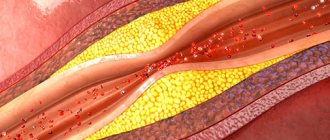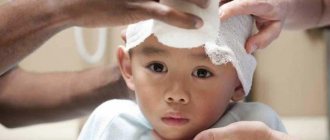Reasons for development
Factors contributing to the development of atheroma on the head are:
- metabolic disorders leading to changes in the properties of the secretion of the sebaceous glands;
- hair dyeing, head shaving with damage to hair follicles;
- hyperhidrosis (especially in combination with seborrheic dermatitis);
- inflammatory diseases of the scalp;
- low-quality hygiene products for hair care;
- Irregular hair washing with the accumulation of viscous oil on the scalp.
Atheromas often form not only on the scalp, but also around the ears and on the chin.
Some babies develop a soft lump on their head soon after birth, called a cephalohematoma. Although cephalohematomas require monitoring, they usually do not have any long-term health consequences.
What is a cephalohematoma?
A cephalohematoma is a collection of blood under the scalp.
During the birth process, small blood vessels that cross the thin layer of tissue just above the skull bones are torn. As a result, blood accumulates on top of the skull bone.
Bleeding occurs gradually and usually takes several hours or days after birth, resulting in a cephalohematoma.
Because a cephalohematoma is a collection of blood on the top of the skull, there is no pressure on the brain (since it is located under the bones of the skull). Thus, there is no fear that the child will bleed in the brain.
Are cephalohematomas a common occurrence?
Although rare, cephalohematomas are one of the most common birth injuries, occurring in approximately 0.4-2.5% of all births. They are more common in male children and in deliveries that involve interventions such as forceps delivery.
They are also more common in larger babies, infants of first-time mothers, and babies who are positioned incorrectly in the birth canal (for example, head down but with their backs turned).
Symptoms of cephalohematoma
The most noticeable symptom of a cephalohematoma is a soft lump or bulge on the baby's head. Typically, the bump is skin-colored and has no bruising or redness.
Cephalohematoma can vary in size - from pronounced to less noticeable.
As the cephalohematoma begins to resolve—a process that takes several weeks—you may notice that it changes in texture and appearance. What probably started out as a sticky feeling may turn into a hard bulge. Rest assured, this is just part of the healing process.
You may notice that the center of the bump begins to dissolve before the edges. Some parents say that at this stage the lump has a "crater" appearance. This is also normal and is another sign that the cephalohematoma is going away.
Besides the obvious bulge, sometimes cephalohematomas have complications, as they can cause jaundice in newborns. In more rare cases, they can lead to anemia or infection.
Causes of cephalohematoma
Cephalohematomas usually occur during childbirth, although after birth it can take several hours to several days for the “bumps” to form.
Any intense pressure on a newborn's scalp during labor can cause blood vessels in the periosteum (the thin layer of tissue just above the skull bones) to rupture, resulting in a cephalohematoma.
The most common causes of cephalohematomas resulting from childbirth:
- Use of forceps during childbirth;
- Long labor;
- Long second stage of labor;
- Macrosomia (babies born with unusually large heads, which can make vaginal birth difficult);
- Incorrect position in the birth canal (birth in the gluteal region, birth “sunny side up”);
- Weak uterine contractions, which prolong labor;
- Multiple births (twins or more).
Establishing diagnosis
Cephalohematoma is usually diagnosed upon discharge from the hospital.
Typically, a physical examination is all that is required to diagnose a cephalohematoma. However, in rare cases, your doctor may suspect that something else is causing the bulge.
Neurological, respiratory or cardiovascular symptoms may require further testing. These tests include:
- X-ray;
- CT scan;
- Ultrasound.
Risks and complications associated with cephalohematomas
In most cases, cephalohematomas are simply an appearance problem. They do not pose a danger to children and go away on their own. Cephalohematomas also do not cause pain to the baby, do not harm his brain or any other part of the body.
They also pose no long-term physical danger. However, in rare cases, a cephalohematoma may increase the risk of developing jaundice.
Jaundice of newborns
If bleeding in a cephalohematoma is significant, the baby may develop jaundice as a result of the breakdown of red blood cells that occurs after the cephalohematoma develops.
When cells die, they are destroyed. During the breakdown process, bilirubin is formed. Because red blood cells are not yellow, bilirubin is not present in living red blood cells. But when cells cannot break it down sufficiently, bilirubin accumulates in the body, causing the skin to take on a yellowish tint, along with other physical manifestations such as poor nutrition and lethargy.
Newborns are especially prone to jaundice because their liver is not yet efficient enough to break down bilirubin.
If your child has a cephalohematoma, your doctor will likely ask you to monitor your baby's condition. Here's what should alert a baby:
- Yellowish skin color;
- Yellowish color to white eyes;
- Lethargy (difficulty waking up);
- Difficulty feeding;
- A shrill cry.
Treatment of cephalohematoma
Unless additional complications such as jaundice occur, most doctors will avoid treatment. However, it is necessary to monitor the child's condition.
Draining cephalohematomas is not recommended, since the blood has already clotted. In addition, aspiration has an increased risk of infection and abscess formation.
The best way to treat a cephalohematoma is to leave it alone and give the body time to reabsorb the collected fluid.
How quickly do cephalohematomas go away?
Cephalohematomas usually resolve within 2 weeks to 3 months.
What's the long term?
Cephalohematomas may look alarming, but they are only “deep skin problems” and do not affect the child’s body in any way. There are no known long-term complications of being born with a cephalohematoma.
Clinical picture
The cyst is a soft lump with rounded contours, located subcutaneously. Even small atheromas are clearly visible if you part your hair and carefully examine the changed skin.
Non-inflammatory atheromas are painless and do not cause discomfort, but if an infection occurs (which almost always happens with an accidental injury), the symptoms become more obvious. Suppuration of the cyst leads to its increase in size, intense pain, redness of the skin, and local swelling. The skin in the area of the inflamed atheroma is hot, and pus may be released from the outlet of the sebaceous duct.
Lump on the forehead of a baby
The main cause of bumps on the forehead of a baby are mechanical injuries, blows and falls. The formation of a large lump after an impact is normal. Such tumors in most cases do not require seeking specialized medical care. They represent swelling of the soft tissues as a result of a bruise, filling them with blood from damaged vessels and subsequent hematoma rising above the surface of the skin. The bumps on the forehead are the largest, because this is where a large number of small vessels pass. At the same time, this part of the head is more durable compared to the temple or back of the head.
What to do if you have a lump on your child’s forehead
First of all, immediately after a blow or bruise, cold should be applied to the damaged area or lubricated with a special ointment. The hematoma usually resolves completely within three weeks. If this does not happen, then you should seek medical help, as in this case a puncture and removal of the contents may be necessary. In addition, a child who has received a blow to the head for any reason must be carefully observed, noting any unusual moments. With symptoms such as a noticeable decrease in reaction, lethargy, lack of reaction to light and different pupil sizes, sweating, drowsiness, constant moodiness, confusion, you need to consult a doctor. Even more dangerous signs are convulsions, vomiting, loss of consciousness, speech impairment - all this is a reason to immediately call an ambulance, because these symptoms indicate a concussion. In cases of severe injury and a large lump, an x-ray may be taken to ensure there are no cracks in the skull.
Other reasons for the appearance of bumps on the forehead of a baby
Lumps on a child’s forehead may be an individual anatomical feature of the structure of a particular child’s skull. In this case, they are not dangerous and do not require any treatment. Most often, over time, the bump on the forehead smooths out and becomes less noticeable.
There are other types of bumps in infants that can appear on the forehead. These formations include benign tumors, characterized by an unchanged structure and gradual growth. One of the varieties of such tumors is wen (lipoma and atheroma). They can occur on any part of the body, the reason for their appearance is clogging of the sebaceous glands. The distinctive features of these two types of neoplasms are the growth rate, as well as the fact that atheroma suppurates and becomes inflamed much more often. Both of these tumors are treated with surgery.
Another type of benign tumor that occurs on different parts of the body is fibroma. It can reach quite large sizes. The reasons for its appearance are still unknown. This lump does not cause significant harm to health, so if it is small in size, does not grow and does not interfere with normal life, it does not need to be removed. Otherwise, surgery is necessary.
Treatment
The most effective way to remove atheromas with minimal risk of recurrence is radio wave excision using the Surgitron device (USA). The procedure does not require shaving the hair; removal takes place under local anesthesia in 30 minutes. Bleeding does not occur due to instant coagulation of blood vessels. The scalp and hair are not damaged. Removal of the formation is non-contact; after the procedure, the doctor carries out an antiseptic treatment and a follow-up examination of the patient. The procedure is outpatient and does not require hospitalization.
Types of tumors on the head and their signs
Hemangioma
A large growth on the head that occurs when the circulatory system is disrupted. The veins can grow uncontrollably, resulting in a red lump. Under the tubercle you can see a network of blood vessels. Doctors consider hemangioma the most dangerous type of tumor.
It is the hemangioma that leads to disruption and formation of the surrounding tissues of the head. Often this type of tumor is located under the hair. A small hemangioma can grow in size over time and become a malignant tumor. If a hemangioma emerges, you must seek specialized medical help.
Allergic reaction
A bump on the head occurs when the human body is exposed to certain allergens. An allergic reaction is caused by food, household chemicals or cosmetics. Such bumps itch and bring a lot of unpleasant sensations to a person. To avoid the formation of such bumps, you should optimize your diet and buy products only from trusted manufacturers.
Fibroma and sarcofibroma
Fibroma is a benign tumor. It consists of connective tissues of the scalp. Fibroids appear on the back of the head, forehead and other parts of the body. In an adult, the tumor can reach significant sizes. The main factors that provoke the occurrence of fibroids: heredity, diabetes or hormonal imbalance. Fibrosarcoma has similar causes, but is a malignant tumor. If left untreated, it leads to death. Most often, fibroma is hard to the touch and does not cause pain to a person.
Lipoma on the head
Lipomas form on damaged human fatty tissues. These are benign tumors. Women over 30 years of age are susceptible to developing growths. Frequent changes in hormonal levels and impaired fat metabolism lead to the formation of lipomas. Such tumors develop both on the head and on other parts of the body. The lipoma is round in shape and soft to the touch. It can be detected in the hair on the back of the head.
Pimples and bites
A person can detect the presence of a lump if it is bothersome and itchy. It could be a bite or acne. Occurs due to poor hygiene or inflammation of the scalp. It does not require specialized medical treatment and goes away on its own within a few days. To speed up healing, you can use compresses or creams.
Bruise or injury
The human body is often susceptible to various types of bruises. And the head is no exception. With a severe bruise, a tubercle forms, which is very painful when touched. This lump is distinguished by its red color and swelling. Heals on average within a few days. If the headache does not go away, you should visit a specialist. This will help rule out traumatic brain injuries.
A wart is a benign tumor that reaches a significant size. This brings a person a lot of unpleasant sensations, in particular due to appearance. The main factors that provoke the development of warts: hormonal imbalance, inflammation and mechanical damage. Warts, in addition to their slow growth, are capable of multiplying and occupying a significant part of the skin. The cone itself resembles a small brown ball. It's not painful. The wart is constantly growing and reaches 0.5 cm in diameter.
Atheroma on the head
Atheroma is growths on the skin. They occur at any age. Both men and women suffer from this disease. It occurs due to blockage and obstruction of the sebaceous glands on the head. Atheroma has a convex and smooth surface, most often yellow. If atheromas are not removed, they hurt and cause discomfort. Lipoma and atheroma are very similar in appearance, so only a doctor can make an accurate diagnosis after diagnosis.
Wen on the head
A lump on the head is a hard, round tumor. Wen forms over the human skin. Fatty spots occur due to hormonal imbalances and frequent stressful situations. They usually have a non-infectious etiology. If the wen interferes with a comfortable life (clings to clothing), it is removed. Removal takes place in a hospital under the supervision of a doctor.
Childhood is a wonderful time, you can play and fool around, ride a bike and climb trees. Of course, most fun games don't come without bruises, scrapes and bumps. What to do if a child falls and hits his head? Or you found a bump on the head, but the baby did not fall. Should I worry and when should I consult a doctor?









